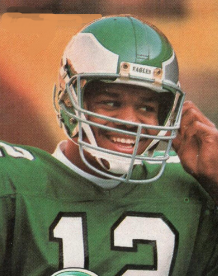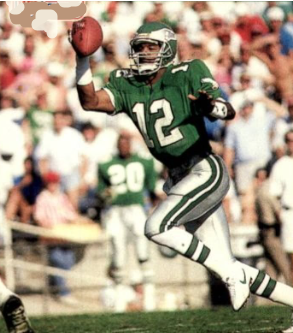By John Turney
Dual-threat quarterbacks who dazzle with their feet as well as incredible arm strength are everywhere in today's NFL. Lamar Jackson and Jalen Hurts are ready examples. So was Colin Kaepernick, at least for a while. And two decades ago, it was Michael Vick with his rare running ability and elite arm.
But they weren't the first with such a skill set -- at least to extreme levels. No, that distinction belongs to Randall Cunningham the godfather of that kind of play for NFL quarterbacks.
Cunningham not only could run for big gains; he would get the ball down the field, too. Granted, there were other quarterbacks who could scramble and run successfully, but only one before Cunningham was a threat to gain 1,000 yards on the ground -- Bobby Douglass of the Bears -- and he was an extraordinarily inaccurate passer.
Cunningham was different. He could complete passes and complete them downfield. He brought something new to the modern NFL, something not seen since pocket passers first dominated the league -- a quarterback who could run for 1,000 yards, pass for well over 3,500 and throw 30 touchdown passes.
For some reason, however, that's not enough to win him support from Hall-of-Fame selectors Eligible since 2007, Cunningham has yet to be a modern-era semifinalist or finalist.
And time is running out.
Per Hall rules, he only has two years left to have his case discussed as a modern finalist. Otherwise, he moves into a senior category stocked with so many Hall-of-Fame worthy candidates that over 50 all-decade choices reside there ... which means Hall-of-Fame voters must act immediately.
It's not simply that Cunningham was accomplished. It's that he was special. A cut above.
Chosen by the Philadelphia Eagles in the second round of the 1985 NFL draft, Cunningham didn't excel immediately. It took him a couple of years, several spot starts and a lot of sacks (at a record rate, no less) before he became ... well, before he became Randall Cunningham. But by 1987, he opened the season as Philadelphia's starter and for the next four years played dynamite, elite football.
In 1988, he threw for 3,808 yards and 24 touchdowns. ran for another 624 yards and six TDs and was the first African-American quarterback to start a Pro Bowl. The passing yardage was third in the NFL and the touchdown passes were fourth best.
In addition to the Pro Bowl, he was second-team All-Pro and second in the AP MVP voting.
But that was the year when he unveiled one of his signature plays to a nationwide audience of millions, one that no one who saw it can forget. It was the 1988 "Monday Night Football" telecast, with the Eagles vs. the New York Giants where, on a third-and-goal, Cunningham rolled right to throw and was hit low by Giants' linebacker Carl Banks, driving Cunningham backward.
Most quarterbacks would have fallen. But Cunningham was not like most quarterbacks. Instead, he stuck out his left arm, regained his balance and popped up to throw a touchdown pass to tight end Jimmy Giles.
"Ladies and gentlemen," said astonished ABC color commentator and Hall-of-Fame tackle Dan Dierdorf, "Randall Cunningham is a ready-for-prime-time player."
"This guy has not been seen by many national audiences before, but I think you’re starting to get the drift as to what kind of football player plays here in Philadelphia. Randall Cunningham … that is a big-time play."
The Eagles were 10-6 that season and reached the playoffs, but they lost to Chicago in a bizarre contest known as the "Fog Bowl where the second-half fog rolling in from Lake Michigan was so thick that no one could see beyond 10 yards -- at least not clearly.
Nevertheless, Cunningham threw for 407 yards.
In 1989, he was chosen to his second Pro Bowl when the Eagles were 11-5 and returned to the playoffs. But they failed to win a playoff game again, this time losing to the Los Angeles Rams. No problem. The following year, Cunningham had his best season ever, throwing for 30 touchdowns and running for 942 yards. Called "The Ultimate Weapon," he was the PFWA MVP and All-Pro quarterback.
It was also that year that he gave us another glimpse of his extraordinary talent, this time dodging Bills' defensive end Bruce Smith (among a couple of other Buffalo pass rushers) in a Houdini-like move to fire a bomb to wide receiver Fred Barnett, who took it to the house.
The play covered 95 yards.
There were more, many more, highlight-reel plays. But they haven't been enough to get the attention of the Hall's board of selectors.
Comparing a player's peak year to his peers is sometimes a useful way to look at statistics. Due to severe injuries, Cunningham's peak was limited. But from the time he became the starter through 1990, his numbers were equal to ... or even surpassed ... plenty of Hall-of-Fame quarterbacks.
From 1987-90, for instance, only Joe Montana and Dan Marino threw for more touchdowns. Hall-of-Famers Warren Moon, Jim Kelly and John Elway trailed him. In fact, among quarterbacks now in the Hall, only Montana exceeded Cunningham in interception percentage, and, among all quarterbacks, only Montana and Marino completed more passes. Only Joe Montana led his team to more wins, too. And when you add rushing touchdowns to passing touchdowns, no one accounted for more.
Not even Montana.
Then there's this: Cunningham called all his plays, something not done by all of his peers. But his coach, Buddy Ryan, trusted the young, 6-foot-4, 215-pounder, and the results speak for themselves.
Granted, his impact was limited for a considerable stretch because of injuries that forced a one-year retirement. But by 1998, he was back -- and in a big way. He teamed that season with rookie Randy Moss and veteran Cris Carter to lead the Minnesota Vikings to the NFL's best record (15-1) with the NFL's best offense.
Cunningham threw a career-high 34 touchdowns, led the NFL with a 106.0 passer rating and was named All-Pro for the second time. He was also the NEA MVP for the third time, second in the AP MVP voting and the PFWA's Comeback Player of the Year for the second time (the first was in 1992).
It was a magical season that should have been punctuated by an exclamation point. Sadly it wasn't. The league's best team failed to reach the Super Bowl when a missed Gary Anderson field goal (his first of the season) in the NFC championship game kept them from beating Atlanta.
For his career, Cunningham threw for just under 30,000 yards and ran for just under 5,000. He had 207 touchdowns passing, 35 rushing and was 82-52-1 as a starter and 3-6 in the playoffs. While the postseason record could be considered a hindrance to Canton, it shouldn't. It's comparable to Hall-of-Famers Warren Moon and Dan Fouts. Moon was 3-7 and Fouts 3-4. Plus, Cunningham's .611 regular-season winning percentage was better than both.
Fouts and Moon were inducted as elite passers. Cunningham was an elite football player. And he deserves consideration on that basis. It's unfortunate that he never played in offenses featuring a pistol formation or one that incorporated read-option concepts. With his freak-like athleticism, he'd be an annual MVP candidate.
At his peak, Randall Cunningham was an elite player who re-pioneered his position, and that's how he should be weighed and measured by Hall voters. But that hasn't happened, and little time is left.




BW ...
ReplyDeleteDid Jerome Brown's death and the Eagles players reactions and performances thereafter -- keep Cunningham out of the HOF?
A pall seemed to have engulfed the city and its players and everyone left rather than winning it all.
Cunningham himself had injury problems in 1991 and 1993 but seemed emotionally spent by the time he was released in 1996.
Maybe HC Ray Rhodes felt he was unreliable or needed a change of scenery but even after the great 1998 season, I felt HC Dennis Green gave up on him too soon in 1999. He should have let him play through his slump but wanted to see if Jeff George could provide a spark. George did but came apart in the postseason. The king of watching loose fumbles going to the other team.
Dallas and Baltimore gave up on him too soon as well. I thought he could win as starter for both teams.
Eagles fans can only wonder what could have happened had Jerome Brown not had that fatal accident. No day is ever guaranteed to anyone.
All good points. The loss of Brown was big. As far as 1999, Cunningham just didn't have it. Wasn't sharp. I think Green did what he had to. I saw all those games that year. Cunningham, had to explain, but lost it.
ReplyDeleteGeorge came in and did so much better. That was Cunningham's issue--kind of hot and cold. I think that's why he's not a HOFer -- injuries and lack of consistency.
Another great post as usual. As impressive as Cunningham's accomplishments were from 1987 - 90, I always wonder if he could have accomplished even more if he had had a more offensive minded head coach. Buddy Ryan was a brilliant defensive coach, but he seemed to have an almost philosophical dislike of the offensive side of the game. If they had a head coach or offensive coordinator more along the lines of someone from the Bill Walsh or Don Coryell coaching trees, I think you would have seen seasons with passing numbers that looked like 1998 coupled with the rushing totals we saw from 1987-90.
ReplyDeleteI am sure that a better coach, offensive coach, had to have helped. That said, Cunninghan probaby would have frustraated Walsh or Coryell. Both those offenses based on timing, feet tied to getting throw off on time.
DeleteReads and routes popping open at certain times in progressions. Cunninghams wasn't that kind of guy. Also didn't have a quick release. He did fit in Billick who had a hybrid offense. Vikings offense was based on Redskins running game and that could set up play action. But also with Carter, Moss and Reed he had trememndous help.
Cunningham called his own plays under Ryan and he was allowed to od what he thought best but if something wasnt't there right away, he'd scramble and usually make yards but also would get sacked at a high clip.
But an elite offensive coach could have taught him things he may not have learned until later in his career. You would have to wonder if they could have shortend his throwing motion to allow for quick slants, drive routes and working horizontally like Walsh liked to do.
Coryell was based on throwing to spots...i.e. two yards inside the hash on a dig, for example. Cunningham wasn't that accurate so he'd have to had worked on that.
What would have been great is to see him in what they run know. Maybe a pistol element and read options and second-level read options. He'd be elite now - with these kind of offenses in NFL today, IMO.
BW ...
ReplyDeleteCunningham with the Eagles had one of the most average offensive lines in memory. He proved with the Vikings what he could do with a strong, line.